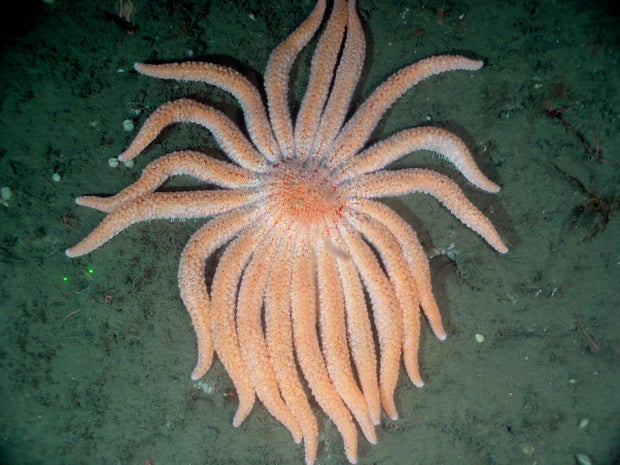Scientists say they’ve eventually solved the thriller of what killed greater than 5 billion sea stars — usually often known as starfish — off the Pacific coast of North America in a decade-long epidemic.
Beginning in 2013, a mysterious sea star losing illness sparked a mass die-off from Mexico to Alaska. The epidemic has devastated greater than 20 species and continues immediately. Worst hit was a species known as the sunflower sea star, which misplaced round 90% of its inhabitants within the outbreak’s first 5 years.
“It is actually fairly ugly,” mentioned marine illness ecologist Alyssa Gehman on the Hakai Institute in British Columbia, Canada, who helped pinpoint the trigger.
Wholesome sea stars have “puffy arms sticking straight out,” she mentioned. However the losing illness causes them to develop lesions and “then their arms truly fall off.”
The offender? Micro organism that has additionally contaminated shellfish, in keeping with a examine revealed Monday within the journal Nature Ecology and Evolution.
Bennett Whitnell/Hakai Institute by way of AP
The findings “resolve a long-standing query a few very critical illness within the ocean,” mentioned Rebecca Vega Thurber, a marine microbiologist at College of California, Santa Barbara, who was not concerned within the examine.
Sea stars usually have 5 arms and a few species sport as much as 24 arms. They vary in coloration from stable orange to tapestries of orange, purple, brown and inexperienced.
“Signs of sea star losing syndrome embrace abnormally twisted arms, white lesions, deflation of arms and physique, arm loss, and physique disintegration,” the Nationwide Park Service says. “They die over the course of days or even weeks.”
It took greater than a decade for researchers to determine the reason for the illness, with many false leads and twists and turns alongside the best way.
Early analysis hinted the trigger could be a virus, however it turned out the densovirus that scientists initially targeted on was truly a traditional resident inside wholesome sea stars and never related to illness, mentioned Melanie Prentice of the Hakai Institute, co-author of the brand new examine.
Different efforts missed the actual killer as a result of researchers studied tissue samples of lifeless sea stars that now not contained the bodily fluid that surrounds the organs.
However the newest examine consists of detailed evaluation of this fluid, known as coelomic fluid, the place the micro organism Vibrio pectenicida had been discovered.
“It is extremely troublesome to hint the supply of so many environmental illnesses, particularly underwater,” mentioned microbiologist Blake Ushijima of the College of North Carolina, Wilmington, who was not concerned within the analysis. He mentioned the detective work by this workforce was “actually sensible and vital.”
Now that scientists know the trigger, they’ve a greater shot at intervening to assist sea stars. The Worldwide Union for Conservation of Nature has listed the sunflower sea star as critically endangered.
Common Historical past Archive/Common Pictures Group by way of Getty Pictures
Prentice mentioned that scientists may probably now take a look at which of the remaining sea stars are nonetheless wholesome — and take into account whether or not to relocate them, or breed them in captivity to later transplant them to areas which have misplaced nearly all their sunflower sea stars.
The examine notes that Vibrio micro organism have been known as “the microbial barometer of local weather change” as a result of the species are extra prevalent in warming water temperatures. The authors say an necessary subsequent part of analysis might be to work on higher understanding the connection between rising seawater temperatures and sea star losing illness.
Scientists can also take a look at if some populations have pure immunity, and if remedies like probiotics might assist enhance immunity to the illness.
Such restoration work is just not solely necessary for sea stars, however for total Pacific ecosystems as a result of wholesome starfish gobble up extra sea urchins, researchers say.
Sunflower sea stars “look form of harmless whenever you see them, however they eat nearly every little thing that lives on the underside of the ocean,” mentioned Gehman. “They’re voracious eaters.”
With many fewer sea stars, the ocean urchins that they normally munch on exploded in inhabitants — and in flip devoured up round 95% of the kelp forest s in Northern California inside a decade. These kelp forests present meals and habitat for all kinds of animals together with fish, sea otters and seals.
Researchers hope the brand new findings will permit them to revive sea star populations — and regrow the kelp forests that Thurber compares to “the rainforests of the ocean.”












